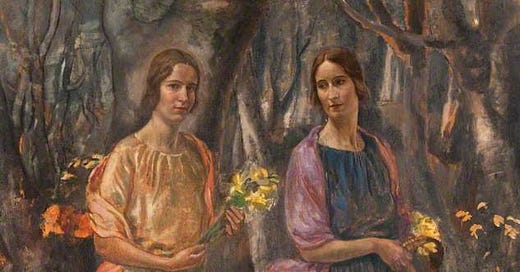Hello,
The ninth month is upon us and I’m back with some rumination and a poem :)
I mentioned in my previous newsletter that I’ve been reading Elena Ferrante’s Neapolitan novels. I’m now in book two, The Story of a New Name, and I paused to think around this passage.
“[…] her life continuously appears in mine, in the words that I've uttered, in which there's often an echo of hers, in a particular gesture that is an adaptation of a gesture of hers, in my less which is such because of her more, in my more which is the yielding to the force of her less. Not to mention what she never said but let me guess, what I didn't know and read later in her notebooks.”
The main character makes this observation about her relationship with her friend. To give you more context, the whole 4-part series is about a woman telling us the story of her long, strained and intense relationship with her friend from childhood. Both characters are extremely interesting and I’ve been very drawn to their story.
Twins of Craigie Hall by Robert Sivell (1888–1958)
© the artist's estate. Photo credit: Paisley Museum and Art Galleries, Renfrewshire Council Collections
I’ve been amazed at how well the narrator has been able to tear herself apart like this. She’s nonchalant about a lot of things right from her irrepressible need to please others. And in the paragraph above, she’s talking about mirroring, of having absorbed someone so well that she feels their shadow in almost everything she does. She’s brazenly open in accepting how much the other person is present in herself and has encroached upon her own personality. I think it takes a lot to even be able to recognise it.
What I’m trying to understand here is in the mirroring. What begins in infancy continues, morphs and develops into full-blown personalities. Sometimes we tend to move from person to person, sometimes we find our parents emerging from within or sometimes it’s the spouse. How natural it feels to mimic, to mirror.
When it comes to developing an art practise, I think mirroring becomes the first step. With writing, a lot of it stems from how well you’re able to understand people, think from their place… When I feel most crammed in the head, I pick up a favourite writer’s work and spend some time in their head. It has helped me arrive at my own thoughts. But with mirroring, they say, one also needs to be careful of becoming a fake, an imposter, of appropriation… I won’t get into that here but I feel its worth our time to think of all those who inhabit our self. How they did what they do to us and most importantly, do they seep into the work that we do? I hope not. I hope the work that I do comes from an untouched, deeper place that’s uniquely me, (the soul?). But I also acknowledge that the “me” is made up of many different people I’ve known in my life. I don’t really know the answer to this but I hope you’re thinking about it too.
Here’s a poem by Mary Oliver that I thought is apt to end this newsletter, with some questions about the “soul”.
Some Questions You Might Ask Is the soul solid, like iron? Or is it tender and breakable, like the wings of a moth in the beak of an owl? Who has it, and who doesn't? I keep looking around me. The face of the moose is as sad as the face of Jesus. The swan opens her white wings slowly. In the fall, the black bear carries leaves into the darkness. One question leads to another. Does it have a shape? Like an iceberg? Like the eye of a hummingbird? Does it have one lung, like the snake and the scallop? Why should I have it, and not the anteater who loves her children? Why should I have it, and not the camel? Come to think of it, what about maple trees? What about the blue iris? What about all the little stones, sitting alone in the moonlight? What about roses, and lemons, and their shining leaves? What about the grass? - Mary Oliver House of Light, Beacon Press, Boston (1990)




